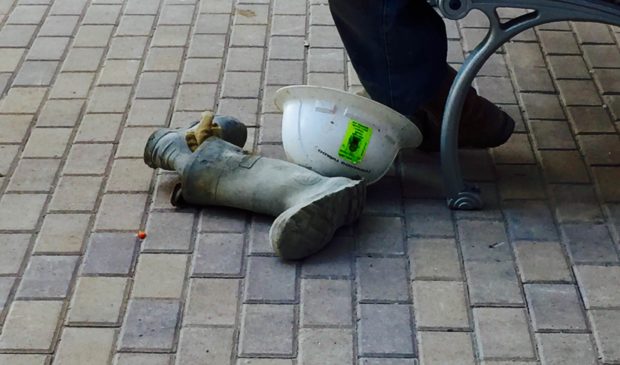Who’s building Austin? As city grows, construction workers are getting left behind
Thursday, September 1, 2016 by
Cate Malek At the end of the workday in downtown Austin, streams of construction workers start pouring out of the city. They spend their days building the condos and office buildings that will make up the new Austin, but they go home to surrounding suburbs and cities where they can afford to live.
Much has been made of Austin’s rapid growth, but labor advocates say the people responsible for building the city have been lost in the rush. Texas construction workers face a litany of problems, from low pay to lack of workers’ compensation insurance to insufficient training, among many others.
This week, City Council may try to address some of those issues for workers in Austin with a proposal that would offer developers a faster permit review process in exchange for adopting worker protections. But the proposal has proved controversial among those who say it will further weigh down an already burdensome permit system.
“While I understand why those that have the means to pay for the expedited review would want to just be able to pay for it and be done with it,” Council Member Greg Casar told the Austin Monitor, “I think that there’s a great community benefit that we can get by setting up requirements for affordable housing and worker protections as part of that process.”
Felix Jimenez knows intimately how difficult it can be to do construction in Austin. Originally from Córdoba, in southeastern Mexico, Jimenez, 40, works in roofing, one of the more dangerous construction jobs.
He remembers one job nine years ago. The work was difficult, with 12-hour shifts in the Texas sun with only one hour for a lunch break. He and the other five workers were being paid only $5 per hour. After six months of work, the contractor refused to pay them. For Jimenez, this was devastating.
“It was December,” he told Monitor in Spanish. “It was hard because I couldn’t buy gifts for my children or pay rent. It was a lot of pressure.”
Through legal action and after some negotiations with his employer, Jimenez was able to recover the $4,000 he was owed. But he said the experience is common.
“It happens a lot,” he said, and then after a pause, “always.”
Jimenez actively supports the proposal to include worker protections in the expedited permit review process. He has been advocating for the Workers Defense Project, one of the backers of the worker protection proposal.
Although Jimenez doesn’t have legal papers to work in the United States, he was adamant about using his real name because he wants to stand up for himself and other construction workers.
“We have to have courage because we have seen so many of our friends go through hard times,” he said.
The statistics back up Jimenez’s account. Like him, the large majority, over 80 percent, of Texas construction workers are Hispanic or Latino, according to a yearlong study conducted by WDP, the University of Texas and others. Also, like him, 22 percent of workers said they had been denied payment for their work, the report said.

A volunteer with Casa Marinela prepares a sign for the Worker’s Defense Project rally at a meeting on Tuesday, August 31.
There are other problems as well. Texas is the only state in the U.S. without a mandatory workers’ compensation insurance system, meaning that oftentimes when construction workers are injured on the job, they have no recourse.
More than half of construction workers in Texas are paid poverty-level wages, according to the WDP report, and more construction workers die on the job in Texas than in any other state. This last statistic was driven home yesterday, when one worker was killed and another injured when a construction trench collapsed in Lockhart, Texas.
The worker protection proposal seeks to address some of the most glaring issues with workers’ rights in Austin. In order to receive an expedited review process, developers would have to provide workers with a living wage, “OSHA 10” safety training, workers’ compensation insurance and independent on-site monitoring. They would also be asked to hire locally, instead of recruiting workers from outside the area. Residential developers would be required to invest in the city’s affordable housing program.
Sunshine Mathon, who works with Foundation Communities, a nonprofit developer that builds affordable housing projects in Austin, said he was strongly in support of the proposal. According to Mathon, the expedited review process is badly needed in Austin. When asked if the permit review process was difficult, he laughed.
“Folks in the city recognize that it’s insane,” he said. It often takes six to seven months for his organization to get through the permit review process.
Nonetheless, he supports adding worker protections to the process as well. Foundation Communities has worked with WDP on two of its past projects and said that it was successful. Although working with WDP took some extra communication, Mathon said it wasn’t burdensome and led to a good outcome for all involved. However, other developers have deep concerns that the proposal will add further bureaucratic complications to an already difficult system.
For workers like Jimenez, though, the worker protections can’t come fast enough. In addition to challenges with insurance, pay and training, construction workers must grapple with the city’s increasing cost of living, which is prompting many to leave Austin.
When asked if he lives in Austin, Jimenez said, “I used to.” After his rent got too high, he and his family moved to Kyle, Texas. Although he is advocating for workers in Austin, Jimenez has joined the many workers who are building the city but can no longer afford to live in it.
The Austin Monitor’s work is made possible by donations from the community. Though our reporting covers donors from time to time, we are careful to keep business and editorial efforts separate while maintaining transparency. A complete list of donors is available here, and our code of ethics is explained here.
You're a community leader
And we’re honored you look to us for serious, in-depth news. You know a strong community needs local and dedicated watchdog reporting. We’re here for you and that won’t change. Now will you take the powerful next step and support our nonprofit news organization?




